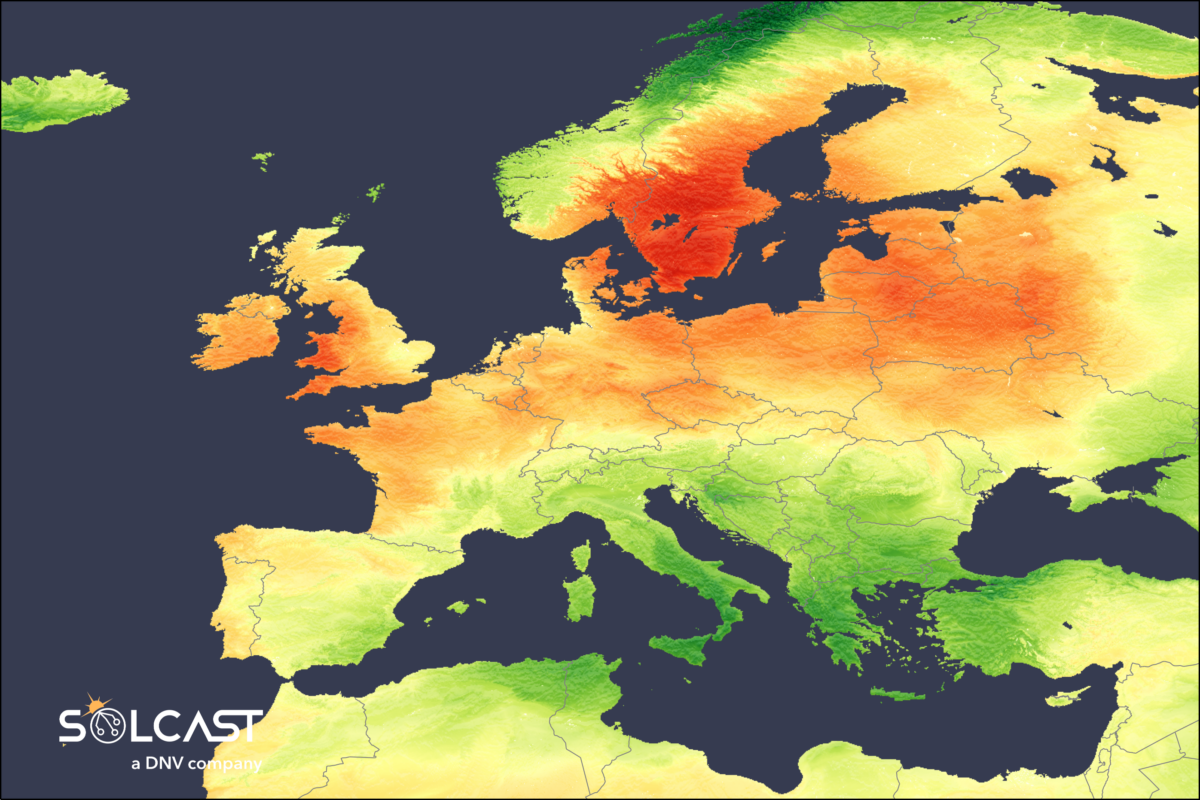High pressure dominated in northern Europe in May resulting in scarce precipitation and cloud cover. On the contrary, southern Europe saw more moisture and cloud-bearing low-pressure systems with solar radiation down by as much as 60% of the climatological means for the period.
Solcast data for the month shows that the below-average cloud cover meant above normal irradiation for much of the UK, France, Germany, the Baltics and Scandinavia, with anomalies as high as 30% and 40% above climatological means. Solar assets across Northern Europe will have overperformed on expectations for May.

Southern European weather moves north
The positive phase of the Arctic Oscillation (AO) causes weather patterns to move northwards, as the Arctic polar vortex contracts inwards. In a more typical May, a belt of high pressure sits over Spain, France and Italy – causing stable and sunny conditions over southern Europe, with fronts and low pressure bringing clouds and showers to northern Europe.
This May, the belt of high pressure sat much further north – across Scotland Norway and the Baltics – delivering more sunshine to the north, whilst also allowing more low pressure, storms and cloud to form over the Mediterranean.

High pressure brought in moisture from the Atlantic to southern Europe, delivering record levels of precipitation. The abundant rain, coupled with a prolonged period of drought, caused inundations in Spain, Portugal, Slovenia, the Balkans and Italy, where floods killed 13 people.

Absolute values of daily irradiance from Solcast data for Europe in May paint an unfamiliar picture with northern Europe and the Baltics seeing higher levels of irradiance for the month than southern Italy and Greece. This will have driven higher than expected performance from solar assets in northern Europe, whilst the Mediterranean rain and storms depressed solar generation.

Solcast produces these figures via its irradiance forecasting and weather API by tracking clouds and aerosols at 1 to 2 km resolution globally using satellite data and proprietary AI/ML algorithms. This data is used to drive irradiance models, enabling Solcast to calculate irradiance at high resolution, with typical bias of less than 2%, and also cloud-tracking forecasts. This data is used by more than 300 companies managing over 150 GW of solar assets globally.
The views and opinions expressed in this article are the author’s own, and do not necessarily reflect those held by pv magazine.
This content is protected by copyright and may not be reused. If you want to cooperate with us and would like to reuse some of our content, please contact: editors@pv-magazine.com.



2 comments
By submitting this form you agree to pv magazine using your data for the purposes of publishing your comment.
Your personal data will only be disclosed or otherwise transmitted to third parties for the purposes of spam filtering or if this is necessary for technical maintenance of the website. Any other transfer to third parties will not take place unless this is justified on the basis of applicable data protection regulations or if pv magazine is legally obliged to do so.
You may revoke this consent at any time with effect for the future, in which case your personal data will be deleted immediately. Otherwise, your data will be deleted if pv magazine has processed your request or the purpose of data storage is fulfilled.
Further information on data privacy can be found in our Data Protection Policy.